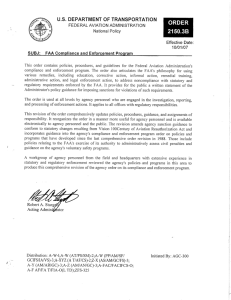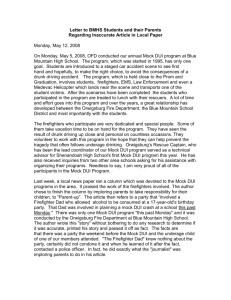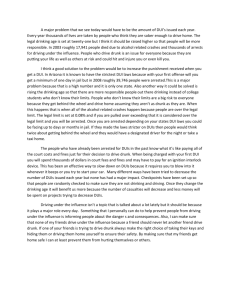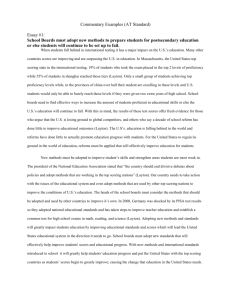DCHS Substance Use Disorders Statewide Conference August 11
advertisement
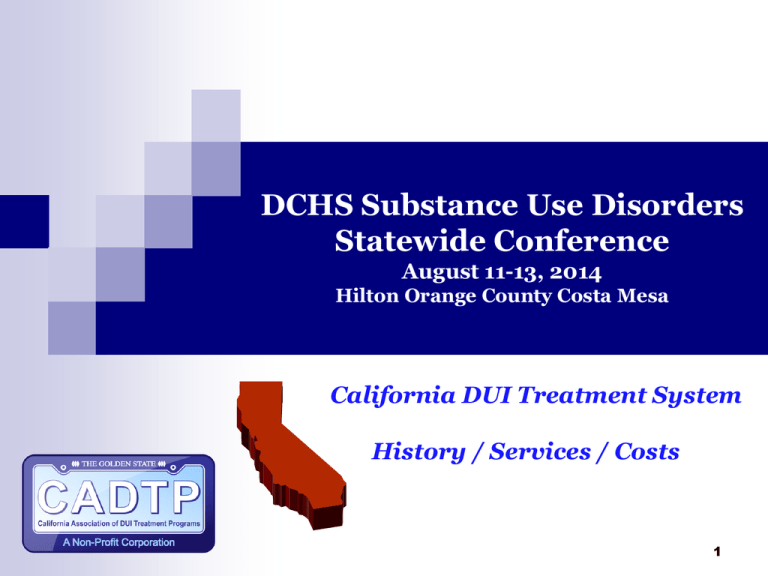
DCHS Substance Use Disorders Statewide Conference August 11-13, 2014 Hilton Orange County Costa Mesa Al California DUI Treatment System History / Services / Costs 1 Your Presenters Bob Dorris Retired, The High Road Program CADTP Board of Directors CADTP Counselor Certification Board bobdorris@hrpinc.org Barbara Aday-Garcia OHS San Marcos CADTP Board of Directors Barbara.L.Aday-Garcia@mhn.com Craig French Twin Palms Recovery Center CADTP Board of Directors craigfrench54@gmail.com 2 History of DUI Treatment Services Pre-Conviction Era Prior to 1978 there was no formal DUI treatment system in California. DUI program services were provided by a number of courts throughout the State. Individuals were referred by the court to the programs on a pre-conviction basis. Successful completion of the program (as developed by the provider) resulted in the dismissal of the charge by the Court. While these program services were for the most part very successful, There was no uniformity of services. 3 History [continued] In 1978 the California Legislature mandated development of programs that would be designed to reduce the high level of recidivism of individuals arrested and convicted of driving-under-theinfluence [DUI], endangering public safety by individuals consuming alcohol and drugs and driving on California streets and highways. The legislature passed Senate Bill 38 creating a post-conviction program and assigned the Department of Alcohol and Drug Programs responsibility for developing regulations based on state law, i.e. §11836 – §11837 of the California Health and Safety Code, and §23161 – §23181 of the California Vehicle Code. The initial focus of the legislature was on alcohol related offenses. Over the past thirty-six (36) years, program services have evolved to focus on any type of DUI offense, i.e. alcohol, licit [prescription] and/or illegal drugs. 4 History [continued] For over 25 years the California Department of Motor Vehicles [DMV] has conducted annual outcome studies on the effectiveness of the California DUI treatment system in reducing recidivism. The 2012 report from the DMV states that recidivism has declined by 44.7% for 1st offenders and 46.4% for 2nd offenders over the last 20 years. 5 The DUI System Today DUI programs are licensed by the Department of Health Care Services to provide a less intensive level of outpatient alcohol and other drug treatment services focused on improving public health and safety by reducing and/or eliminating additional DUI offenses. These services consist of education classes (prevention); individual and group counseling sessions (intervention); and in some counties individual client involvement in self-help programs to facilitate ongoing recovery from the abuse of alcohol and drugs. Consistent with state regulations DUI treatment is provided by alcohol and other drug counselors certified under Chapter 8, Division 4, Title 9, California Code of Regulations. 6 The DUI System Today DUI treatment programs collaborate with the Courts and the Department of Motor Vehicles to ensure compliance with their summary or formal probation requirements and prepare clients to regain their to drivers license by successfully completing their DUI treatment program. While program services are focused on refraining from operating an automobile [or any mode of transportation] while under-the-influence, DUI services also provide clients with a new understanding of their individual responsibility to themselves, their families, and their community, and a healthy new approach to their use of alcohol and drugs. 7 Myth vs. Fact Myth: “DUI program providers are allowed to charge exorbitant fees and make huge profits”. Fact: DUI program fees are approved and controlled by the Department of Health Care Services and by law are limited to earning a maximum 10% profit/surplus of total DUI revenue 8 Fee Structure DUI treatment program fees are regulated under §9878 – Chapter 3, Division 4, Title 9, California Code of Regulations. In part these regulations state: The licensee shall charge only the program fee and any additional fees that have been approved by the Department pursuant to this section of regulation. The licensee shall not increase program fees unless a request has been submitted to the county alcohol and drug program administrator and approved by the Department. The program shall establish and use a standardized payment schedule, approved by the Department in accordance with this subsection, to determine each participant's assessed program fee and schedule for payment of fees. 9 Myth vs. Fact Myth: “There is little or no oversight of DUI program providers and the statewide DUI treatment system”. Fact: The California Department of Health Care Services licenses all DUI treatment programs and regulates the delivery of services as prescribed in Chapter 3, Division 4, Title 9, California Code of Regulations, and provides analysts who conduct on-sight compliance visits bi-annually. In addition, the County Alcohol and Drug Administration of each county has responsibility to monitor compliance of the DUI treatment programs within their county on a consistent basis throughout any given year. 10 Myth vs. Fact Myth “DUI treatment service providers receive state and/or county funding to provide services to clients.” Fact California’s DUI treatment system is one hundred percent (100%) selffunded by program fees paid by the client. From inception of the system in 1978, the State Legislature made it mandatory that the system would be self-funded. That remains true today … there is no tax-payer money funding the system and its services. The DUI Programs collect participant fees for providing program services plus fees to reimburse the State and County for their monitoring and compliance auditing services as required by state law. 11 Fee Structure Clients pay as services are delivered. Provisions are made in fees based on the client’s income and ability to pay. The regulations provide for clients who are unemployed and who are on county general relief receive a substantially reduced fee. Program profit or surplus shall not exceed The program fee shall be set at a level sufficient to cover the cost of program services, including each participant's share of personnel and operating expenses incurred by the program in providing program services. 10% of gross revenue from fees per annum. 12 Myth vs. Fact Myth “DUI Program Services are costly and a financial burden to the client.” Fact The actual cost of treatment services statewide ranges from a low of $15.00/hour to $27.00 /hour of service, depending on the level of program the client needs to complete, (shown below). Program fees vary between counties, but all counties are within fee ranges stated above. Wet Reckless Program 3-Month Program 6-Month Program 9-Month Program 18-Month Program 30-Month Program 13 DUI Program Services 14 DUI Program Services The DUI programs primary goal is to assist participants to explore their relationships with alcohol/drugs and the inherent risks involved The desired result is modified drinking and/or drug use in high-risk situations such as driving Our programs provide counseling and education to assist in reducing the recidivism rate of DUI offenders Myth Fact DUI Programs are Education not Counseling DUI Program Services DUI Programs take a proactive stance in helping those with alcohol and/or drug dependency problems make life-affirming changes. DUI Programs recognize that substance use behavior exists along a continuum, ranging from non pathological use at one end, to problematic or substance abuse in the middle to chronic substance dependence on the other. DUI services are designed to address this continuum of use through the education, group and individual case management sessions. 17 All AOD Treatment Programs have an Educational Component and so do DUI Treatment Programs Orientation to DUI laws, Alcohol & Drug Impairment and the DUI Program Patterns Of Consumption, Chemical Dependency And Assessment Medical Aspects Of Alcohol And Other Drugs Social Aspects Of Alcohol And Other Drugs Addiction And The Family Recovery, Resources And Options For Change Instructors are certified counselors who must have 2 years of experience providing Alcohol and Other Drugs Education. DUI Program Levels Wet Reckless Program: Blood Alcohol Content under .08 12 hours of education 3-month First Offender Program - 37.5 % education, 62.5% counseling Blood Alcohol Content .08 and above 12 hours of education 10 hours of group counseling 3 individual sessions (face to face) Eight additional hours of program services, consisting of educational sessions, group counseling sessions, or a combination of the two 19 DUI Program Levels 6-month First Offender Program 26.7% education, 73.3% counseling Blood Alcohol Content .15 - .19 12 hours of education 28 hours of group counseling Minimum of 4 individual sessions Four additional hours of program services, consisting of educational sessions, group counseling sessions, face-to-face interviews or a combination of the three 9-month First Offender Program 19.1% education, 80.9% counseling Blood Alcohol Content .20 and above 12 hours of education 44 hours of group Minimum of 5 individual sessions Four additional hours of program services, consisting of educational sessions, group counseling sessions, face-to-face interviews or a combination of the three DUI Program Levels 18-month Multiple Offender Program 15.4% education, 84.6% counseling 2 or more DUI’s in a 10 year period The first 12 months of the 18 month program 12 hours of education, 52 hours of group counseling 1 individual session every other week. The last 6 months of the 18-month program includes up to 6 hours of services. Each program and/or county determines how to structure the last 6 months of service 21 DUI Program Levels 30-Month Multiple Offender Program 7.9% education, 92.1% counseling 3 or more DUI Offenses in a 10 year period 1st 18 months = 12 hours of education, 78 hours of group counseling and one face to face session every other week Last 12 months – DUI Program must continue to monitor compendium of evidence, can credit some time towards last 12 months for residential or in-patient AOD Treatment with court approval Client must show a compendium of evidence, on a tri-monthly basis, of performance of voluntary community service for one-half of the time served (not less than 120 hours and not more than 300 hours, as determined by the court) demonstrating: 1. The prevention of driving-under-the-influence, promotion of safe driving, and responsible attitude toward the use of chemicals of any kind. 2. Significant improvement in occupational performance (including efforts to obtain gainful employment), physical and mental health, family relations, and financial affairs and economic stability. * Not available in all Counties in California 22 Fact Myth DUI Counselors are not Certified Alcohol & Other Drug Counselors Title 9 California Code of Regulations Staff Qualifications DUI program staff who conduct educational sessions shall have a minimum of two years of experience in providing alcohol and/or drug education and information to persons with alcohol and/or other drug problems in a classroom setting or meet the staff qualifications required in Section 9846(c) or Section 9846(f). All DUI program staff who provide counseling services (as defined in Section 13005(a)(4)) shall be licensed, certified, or registered to obtain certification pursuant to Chapter 8 (commencing with Section 13000) or meet the qualifications required in subdivision (f). DUI program staff who provide counseling services (as defined in Section 13005(a)(4)) shall comply with the code of conduct, pursuant to Section 13060, developed by the organization by which they were certified or registered Myth Fact DUI Programs Do Not Provide Treatment Individual Counseling Sessions Face to face sessions address the following questions, 1. “Discuss and identify problems which may be barriers to program completion, including progress in group and other counseling sessions.” 2. “Evaluate the client’s need for referral to ancillary services.” 3. “Discuss and encourage client attendance in educational and counseling sessions.” 4. “Monitor payment of fees.” A formal substance abuse assessment is conducted within 60 days from enrollment, discussed with the client and appropriate referrals are provided and documented. 26 Objectives of individual and group counseling 1. To assist clients in recognizing and eliminating high risk behavior associated with alcohol and drug use i.e. drinking and driving. 2. To provide clients with assessment and referral services to address life management issues that impact healthy functioning and wellbeing. 3. To facilitate the reduction or elimination of alcohol or drug use as appropriate. 4. To stimulate positive behavioral change resulting in increased wellbeing and functioning in major life areas. Problem recognition Taking responsibility Self-regulation Harm reduction 27 The DUI Client 28 A Preventable Tragedy 29 WHO IS THE “TYPICAL" DUI CLIENT? The California DUI client is as unique and diverse as the State’s population The California DUI client runs the full spectrum of cultural, ethnic, and educational background. The DUI offenses occur with no respect to age or gender California DUI clients are from every walk of life and income level, i.e., students, blue collar workers, white collar workers, agricultural businesses , small business, manufacturing, unemployed, health care professionals, retirees and politicians The DUI clients participating in our program mirror the communities we live in 30 CALIFORNIA DEPARTMENT OF MOTOR VEHICLES ANNUAL REPORT OF THE CALIFORNIA DUI MANAGEMENT INFORMATION SYSTEM 2013 2011 DUI ARRESTS 180,212 Race/Ethnicity Number Percentage % California Population White 71,817 39.9% 39% Hispanic 77,257 45.9% 38.4% Black 15,076 8.4% 6.6% Other 16,062 8.95% 15.8% California Population 2013 = 38,332,521 DUI Arrests 180,212 = .0047% of population 1 out of approximately 212.70 people are arrested for DUI 31 2011 DUI ARRESTS 180,212 Gender Male Female Number of arrests 137,866 Percentage of arrests 76.5% % California Population 49.7% 42,346 23.5% 50.3% 32 2011 DUI ARRESTS 180,212 Male Female Average Age 33.7 years 33 years White Hispanic Black Other 35.6 years 31.5 years 35.7 years 31.9 years Average age is 34 years 33 All DUI Clients are Alcoholics or Addicts 34 What we know as providers of DUI services is that our clientele run the full spectrum regarding use/abuse of alcohol and drugs. Some clients do not have a substance use disorder and others may require additional services to address addictive behaviors. 35 DUI Providers have a Singular Mission to Provide DUI Services Only 36 DUI Programs are mandated by Regulations to “Evaluate the client’s need for referral to ancillary services” The referral to ancillary services are based upon the clients assessed needs. i.e. an appropriate level of AOD Treatment, medical issues, food bank, financial assistance, etc. 37 How Clients Fit into DHCS’S Continuum of Care DUI Programs are: Prevention, Assessment , Early Intervention, and Treatment Approximately 150,000 court ordered DUI participants per year are provided support for positive changes in life style to facilitate reduction or elimination of alcohol/drug problems by the DUI Program Providers. This is accomplished through the AOD education, group and individual counseling session , the assessment of their substance use/abuse and the evaluation of the participant’s need for referral to ancillary services. 38 Napa Referrals to Ancillary Services FY 11-12 # Services # referrals % 1 Napa County Alcohol and Drugs Services 12 12% 2 Tobacco cessation (Take charge) 30 30% 3 AA/NA (12 Step Programs 4 Clinic Ole- Behavioral services 25 25% 6 6% 5 HHS Mental health Services 6 Residential Treatment programs 5 5% 9 9% 7 Dental Services (Clinic Ole) 1 1% 8 Other* 11 11% 99 100% Total Referrals Napa Referrals to Ancillary Services Fiscal Year 12-13 * Job Connection,ParentCan, Goodwill, Meals on Wheels, CMSP, FS, IHSS, # Services Total % 1 Napa County ADP 10 8% 2 Tobacco cessation 30 24% 3 AA/NA (12 Step Programs 30 24% 4 CO- Behavioral services 5 4% 5 HHS Mental health Services 3 2% 6 Treatment programs 10 8% 7 Centro Legal la raza 20 16% 8 Carecen 15 12% 9 CO-Dental Services 1 1% # 3 2% 127 100% Other* Total Referrals *Other: Divorce lawyer, Domestic Violence Program, Care giver support 39 Summary of DUI Services Alcohol and drug outpatient treatment and education services 1st stage treatment program – primary gate keeper Prevention specialists, education, assessment Intervention Continuum of care Totally self-funded Effective at reducing recidivism Protect public safety 40 41 A Successful Client = A Safer Community 42
